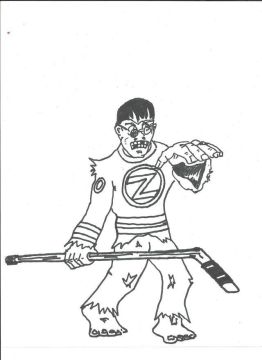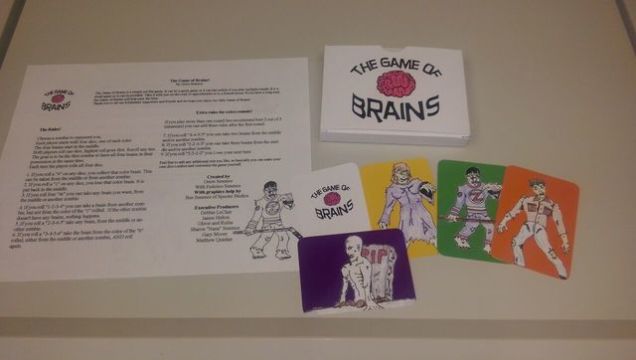In the Beginning
The journey began with what has been an annual event for my brother and I, but a first for my son Orion (and his older brother Dakotah). We made the trek to Boston for Pax East 2015. To say the boys were excited is an understatement. Oh, who am I kidding, I get excited every year too, so being able to share my excitement with them was amazing and memorable.
We made the rounds on the convention floor weaving in and out of people and booths taking in all the glory of the games, enjoying the sights and spending a few bucks on new games for our library. Little did I know it would spark some creativity in Orion.
At some point during the day-long trip he hit me with a “Dad, what if I had a game to sell at Pax?” I responded with a “That would be pretty cool, but you’d have to make a game first right?” That’s all it took.
The Concept
Apparently, Orion already had a game idea brewing in his young mind that I was unaware of. His cousin had a birthday in October prior to the PAX trip and part of the goody bag from the party included several colored brains (it was a zombie themed party). Orion had taken those brains, added some similar colored dice and began the early stages of game development all on his own. Throw in a few basic rules on what to roll to win and he had a foundation to build on. The working title was “The Brain Game” but we eventually changed it because there are a lot of games out there with a similar title.
“To invent, you need a good imagination and a pile of junk.” - Thomas A. Edison
This is the point I started to get more involved. Two thoughts went through my brain: 1. This is a cool little game and is actually fun. 2. It would be really neat to have a game that others could enjoy that I actually had a part in. Being a lifelong gamer, that got me excited. My kiddo had me motivated!
Gaining momentum
Orion and I took the next couple of weeks to mess around with the basic rules of the game to try and get things from concept to potential development. To Orion’s credit, he came up with 90% of the game’s rules with me adding a few tips to ensure it flowed well and worked. At that point, we had an idea that morphed its way into an actual game idea and with the help of some random items in the house we were able to make a prototype of the game.
My recommendation at this point would be to not only play test in house, but play test with other gamers because that is your potential customer base. Of course, you might have to take precautions with trademarks and copyrights (Note copyright laws). Also, be prepared for the occasional overzealous helper who is going to want to help with going a bit overboard. It happens sometimes.
Now we had to take it from prototype to something we could sell to others.
This process was not fun and I warn you all that you will encounter times it is a straight up job if you want it to happen and it should be. Over the course of another two weeks or so I researched multiple companies to try and find the best prices on materials needed as well as trying to find someone to help with some artwork for the game. What helped me was knowing what price point I wanted as far as selling the final product.
My brother ended up helping us with the art after brushing the dust off his talents so that saved us a small chunk of change (thanks bro!). Conventions (comic cons) and tattoo artists are good places to look if you need an artist. So, add a printing company to the needs to print some cards and most importantly the rules sheet. We also made adjustments from player feedback. We originally were going to use small tokens or cardboard cards for the brains to save on cost, but the early feedback suggested the 3D style brains were much more desired. Ultimately I’m glad we made the change because it does improve things. It’s good to keep the customers happy.
After all of that I had a good idea of material cost that would give me a base cost per game so I could subtract that from the price per game and get a basic profit line. If you don’t make a profit it is hard to keep it moving forward. Going with a minimum initial run of 100 games I had our number, but we had no disposable money. Enter Kickstarter! Of course, you can use Indiegogo or other means but crowdfunding is the way to go.
A Dream Becoming Reality
I launched the Kickstarter ( Our Campaign ) and decided to give it no more than three months to fund. I felt if I couldn’t fund in three months than it wasn’t a game that would catch anyone’s attention. We used a pretty standard rewards payout and to our surprise it funded well under the time allotted. Research other games that had successful campaigns to get ideas on rewards and what not. Don’t re-invent the wheel, learn from others’ success. For us, it was on.
Once the campaign for Kickstarter ends it takes another week or two for all the transactions to go through, Kickstarter takes their percentage and then you get your funding money sent and can move forward. Keep that in mind if you have never done a crowdfunding campaign. The site takes a small cut, so if you need $500 don’t ask for $500, ask for $600. Also, it is not uncommon for backers to fall out in the very end, which can lower your money raised totals so again, plan for some movement in your asking price. I also highly encourage you to keep your backers up to date once the campaign ends if not throughout the entire process. I had a hiccup or two but made sure to notify the backers of the delays so they knew I was still working hard on the project (My original printing company fell out of contact so I had to go with my back up. Always have a backup for things).
Add another month to get all the supplies sent to us and a couple of days to assemble the games ourselves and we finally had our finished product (Note - Orion was not too keen on assembling games but he loved playing supervisor while Daddy did the labor). We did it. The game was in hand as a final product! The final title was “The Game of Brains.”
Our Kickstarter backers were first in line to get their games of course and we learned a valuable lesson in that process. We ended up losing a good chunk of change in paying for shipping and handling because we wanted to offer free shipping to our backers. It was nice to do for them, but was an added cost to us that wasn’t properly accounted for. Lesson learned there. Take advantage of the USPS prices as I found them cheaper than UPS.
Finally, I am fortunate enough to have a good relationship with a local game shop owner. He immediately allowed us to put our game on his shelves to sell but that moment was the final piece of success to our goal. We won’t be selling the game at PAX officially, but we will be there and maybe, just maybe we will be in a spot where we can have a booth in 2017.
Be prepared to run game demos at your local shops too. The best advertisement is usually word of mouth from others who enjoy your game. Also hit up social media as that is free, of course.
The moral of the story, dreams come true. With a little hard work, determination and a creative mind or two, it can happen. We are already working on two more games too! Being able to share this process and success with my kiddo has been an amazing experience. I thank you for taking a few minutes to hear our story.
If you are interested in the game we have limited copies available. You can e-mail me directly at “[email protected]” for more information. You can also follow us on Facebook. Any future appearances or info will be posted there as well as any future games that we develop.



